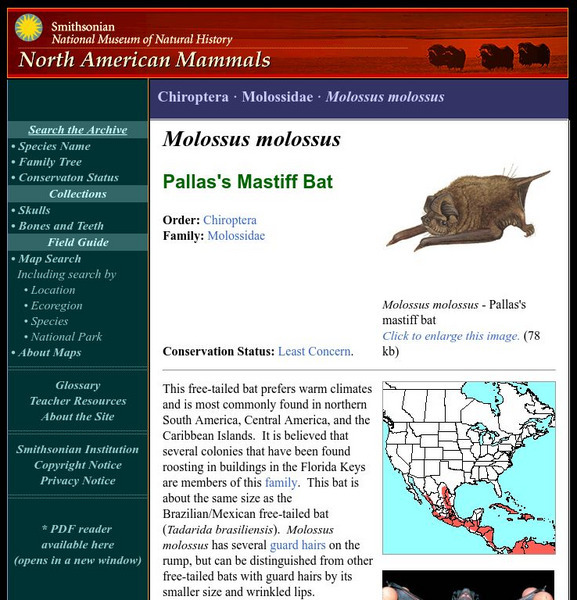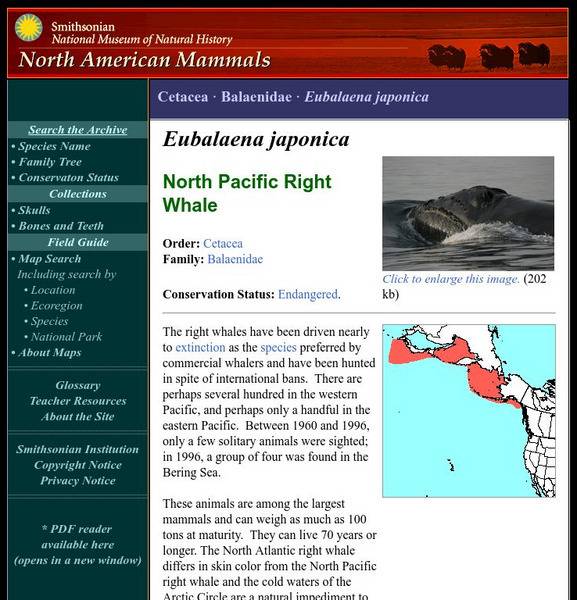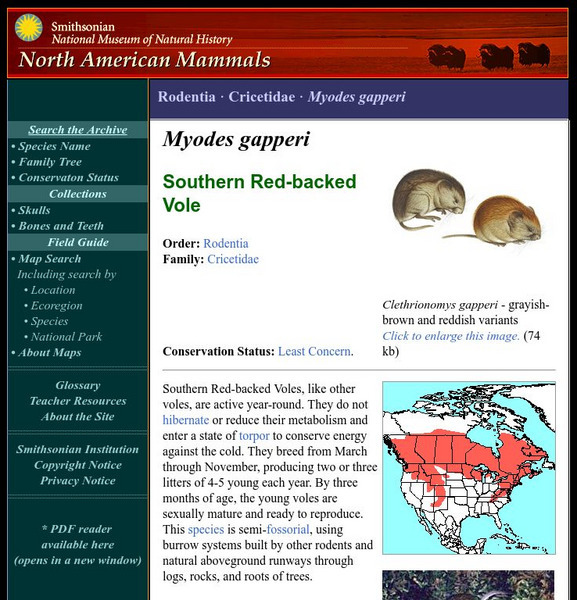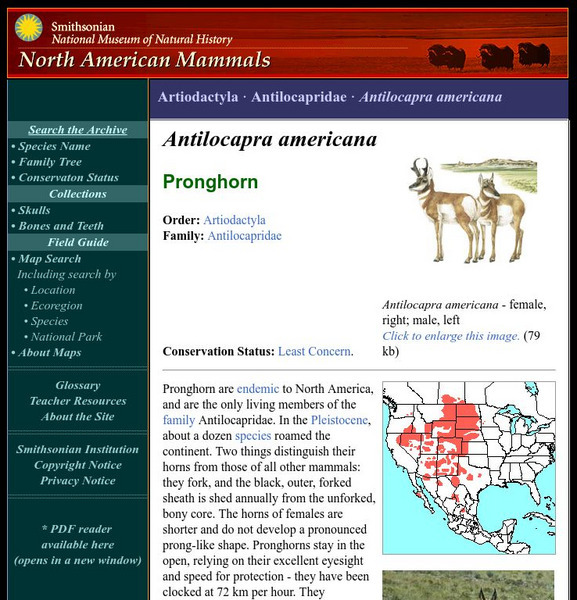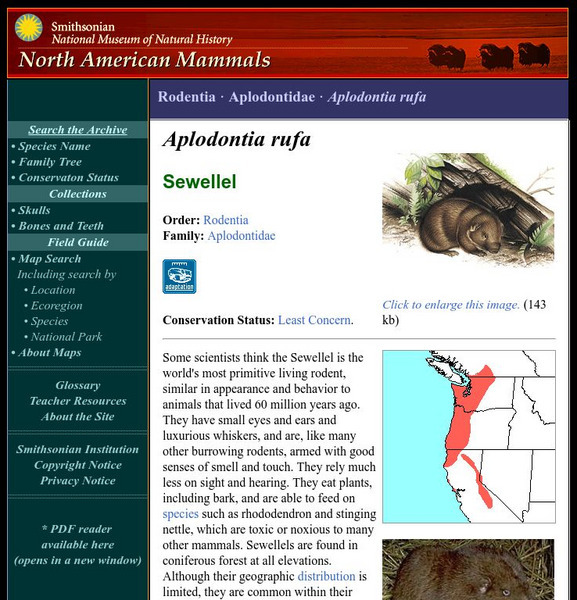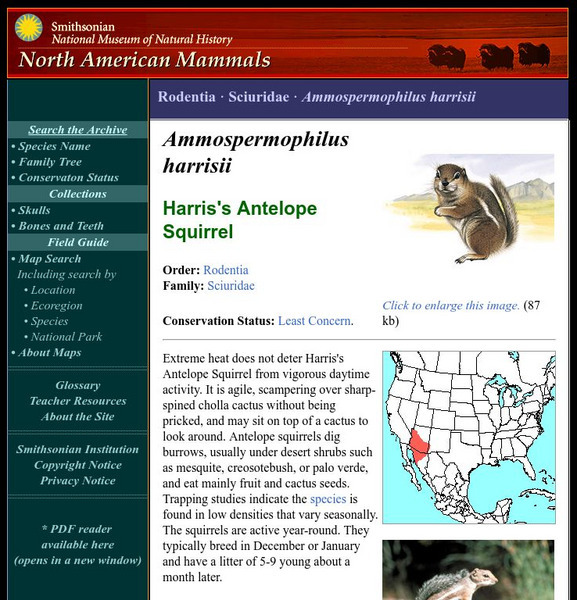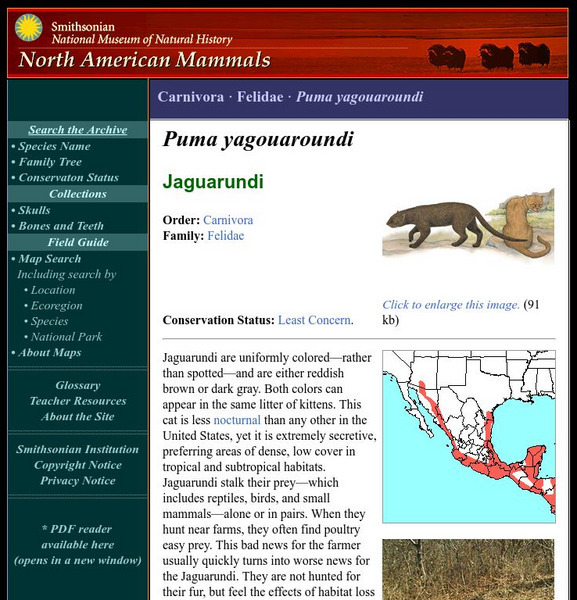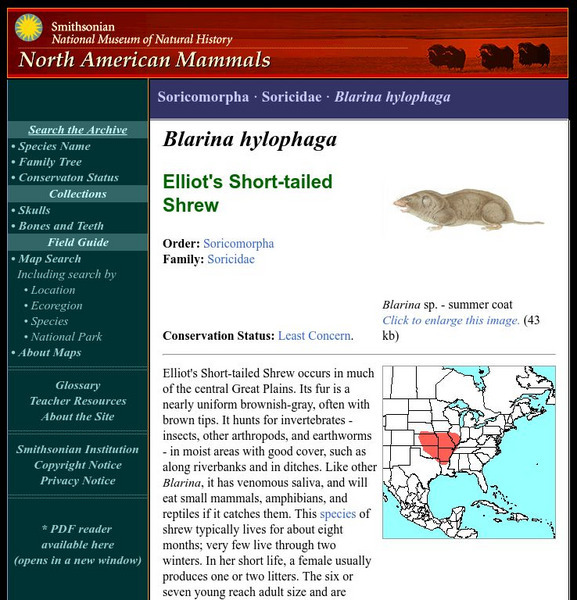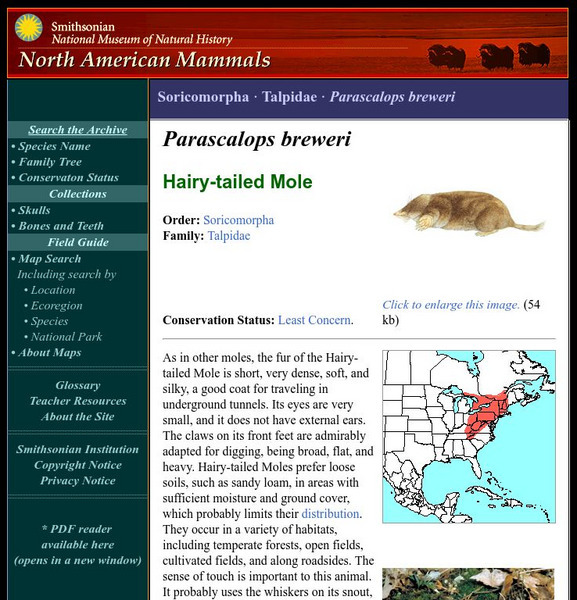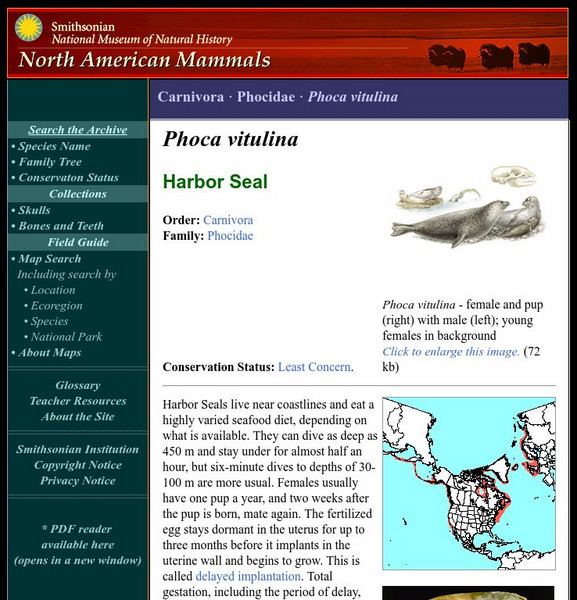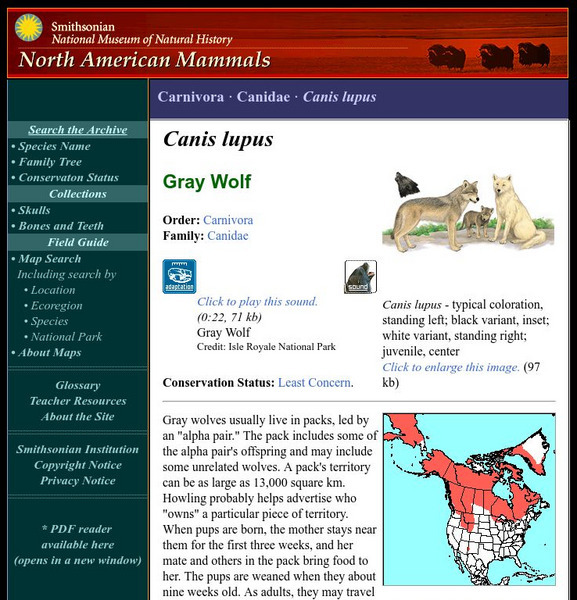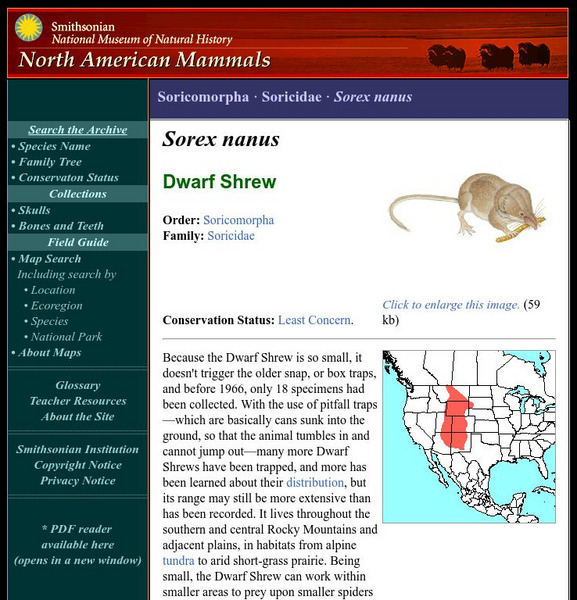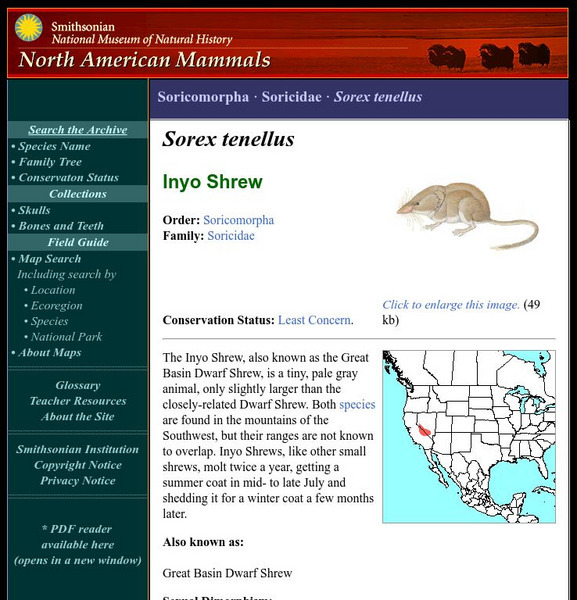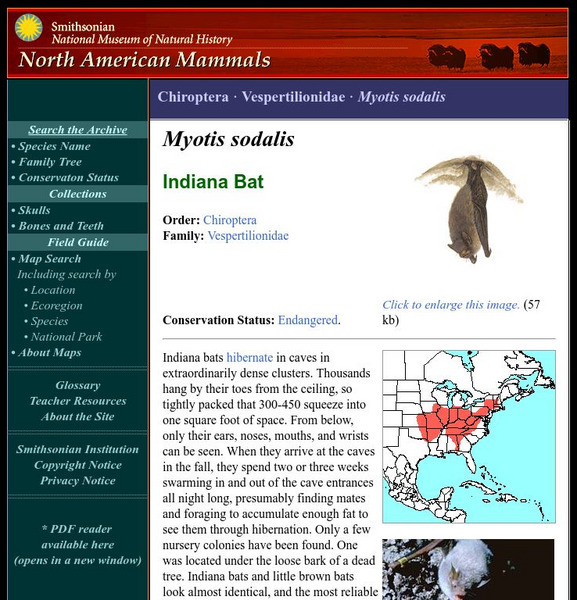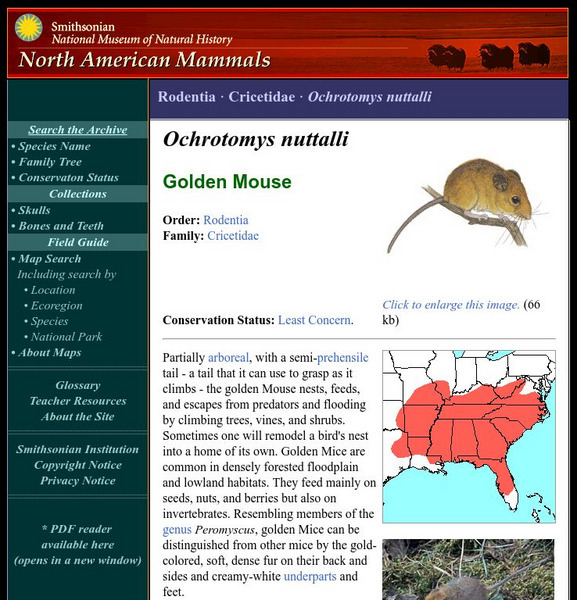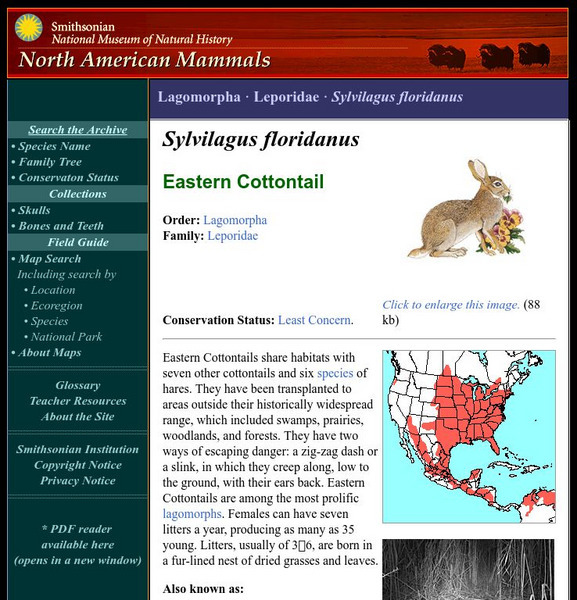Smithsonian Institution
National Museum of Natural History: American Mammals: Pallas's Mastiff Bat
This free-tailed bat prefers warm climates and is most commonly found in northern South America, Central America, and the Caribbean Islands. It is believed that several colonies that have been found roosting in buildings in the Florida...
Smithsonian Institution
National Museum of Natural History: American Mammals: North Pacific Right Whale
The right whales have been driven nearly to extinction as the species preferred by commercial whalers and have been hunted in spite of international bans. There are perhaps several hundred in the western Pacific, and perhaps only a...
Smithsonian Institution
National Museum of Natural History: American Mammals: Southern Red Backed Vole
Southern Red-backed Voles, like other voles, are active year-round. They do not hibernate or reduce their metabolism and enter a state of torpor to conserve energy against the cold. Learn more about the Clethrionomys gapperi, more...
Smithsonian Institution
National Museum of Natural History: American Mammals: Star Nosed Mole
No other mammal in the world looks like the star-nosed mole, which has 22 fingerlike appendages surrounding its nostrils. It has recently been discovered that these very sensitive tactile organs are used for object manipulation, and...
Smithsonian Institution
National Museum of Natural History: American Mammals: Stephen's Kangaroo Rat
Stephen's Kangaroo Rat is endangered, chiefly due to habitat loss. It lives only in isolated populations in three counties of southern California. Learn more about the Dipodomys stephensi, more commonly known as a Stephen's Kangaroo Rat,...
Smithsonian Institution
National Museum of Natural History: American Mammals: Pronghorn
Pronghorn are endemic to North America and are the only living members of the family Antilocapridae. In the Pleistocene, about a dozen species roamed the continent. Learn more about the Antilocapra americana, more commonly known as a...
Smithsonian Institution
National Museum of Natural History: American Mammals: Sea Otter
The Sea Otter is the largest member of family Mustelidae, and the smallest marine mammal. Sea Otters are more aquatic even than seals and sea lions, because they mate and give birth in the water. Learn more about the Enhydra lutris, more...
Smithsonian Institution
National Museum of Natural History: American Mammals: North American Porcupine
North American Porcupines are large, slow-moving, tree-climbing rodents, protected from predators by their formidable quills. In winter, they eat the bark, phloem, and cambium of trees, particularly conifers. Learn more about the...
Smithsonian Institution
National Museum of Natural History: American Mammals: Mountain Beaver
Some scientists think the Mountain Beaver is the world's most primitive living rodent, similar in appearance and behavior to animals that lived 60 million years ago. They have small eyes and ears and luxurious whiskers, and are, like...
Smithsonian Institution
National Museum of Natural History: American Mammals: Harris's Antelope Squirrel
Extreme heat does not deter Harris's Antelope Squirrel from vigorous daytime activity. It is agile, scampering over sharp-spined cholla cactus without being pricked, and may sit on top of a cactus to look around. Learn more about the...
Smithsonian Institution
National Museum of Natural History: American Mammals: Fresno Kangaroo Rat
As might be expected from its name, the Fresno Kangaroo Rat inhabits south-central California. The species is at risk because agriculture takes ever-increasing bits of its habitat. Learn more about the Dipodomys nitratoides, more...
Smithsonian Institution
National Museum of Natural History: American Mammals: Gray Seal
Some 15,000 gray seal pups are born annually on a 25-mile-long sand bar on an island off the coast of Nova Scotia. This is far from the seals' feeding grounds, and both males and females fast during the mating and birthing season. Learn...
Smithsonian Institution
National Museum of Natural History: American Mammals: Jaguarundi
Jaguarundi are uniformly colored, rather than spotted, and are either reddish brown or dark gray. Both colors can appear in the same litter of kittens. Learn more about the Puma yaguarondi (Herpailurus yaguarondi), more commonly known as...
Smithsonian Institution
National Museum of Natural History: American Mammals: Elliot's Short Tailed Shrew
Elliot's Short-tailed Shrew occurs in much of the central Great Plains. Its fur is a nearly uniform brownish-gray, often with brown tips. Learn more about the Blarina hylophaga, more commonly known as Elliot's Short-tailed Shrew, in this...
Smithsonian Institution
National Museum of Natural History: American Mammals: Hairy Tailed Mole
As in other moles, the fur of the Hairy-tailed Mole is short, very dense, soft, and silky, a good coat for traveling in underground tunnels. Its eyes are very small, and it does not have external ears. Learn more about the Parascalops...
Smithsonian Institution
National Museum of Natural History: American Mammals: Harbor Seal
Harbor Seals live near coastlines and eat a highly varied seafood diet, depending on what is available. They can dive as deep as 450 m and stay under for almost half an hour, but six-minute dives to depths of 30-100 m are more usual....
Smithsonian Institution
National Museum of Natural History: American Mammals: Gray Wolf
Gray wolves usually live in packs, led by an "alpha pair." The pack includes some of the alpha pair's offspring and may include some unrelated wolves. Learn more about the Canis lupus, more commonly known as a Gray Wolf, in this...
Smithsonian Institution
National Museum of Natural History: American Mammals: Dwarf Shrew
Because the Dwarf Shrew is so small, it doesn't trigger the older snap or box traps, and before 1966, only 18 specimens had been collected. With the use of pitfall traps, which are basically cans sunk into the ground so that the animal...
Smithsonian Institution
National Museum of Natural History: American Mammals: Inyo Shrew
The Inyo Shrew, also known as the Great Basin Dwarf Shrew, is a tiny, pale gray animal, only slightly larger than the closely-related Dwarf Shrew. Both species are found in the mountains of the Southwest, but their ranges are not known...
Smithsonian Institution
National Museum of Natural History: American Mammals: Dark Kangaroo Mouse
Kangaroo Mice have fat deposits in the middle of their tails. The fat deposits change in size according to the season, being largest when the animals go into hibernation and smallest when they emerge in the spring. Learn more about the...
Smithsonian Institution
National Museum of Natural History: American Mammals: Indiana Bat
Indiana bats hibernate in caves in extraordinarily dense clusters. Thousands hang by their toes from the ceiling, so tightly packed that 300-450 squeeze into one square foot of space. Learn more about the Myotis sodalis, more commonly...
Smithsonian Institution
National Museum of Natural History: American Mammals: Golden Mouse
Partially arboreal, with a semi-prehensile tail - a tail that it can use to grasp as it climbs - the golden Mouse nests, feeds, and escapes from predators and flooding by climbing trees, vines, and shrubs. Sometimes one will remodel a...
Smithsonian Institution
National Museum of Natural History: American Mammals: Eastern Harvest Mouse
Eastern Harvest Mice eat seeds, some fresh green plant matter, and small insects. They prefer damp habitats, particularly meadows, marshlands, and weed-covered banks of irrigation ditches. Learn more about the Reithrodontomys humulis,...
Smithsonian Institution
National Museum of Natural History: American Mammals: Eastern Cottontail
Eastern Cottontails share habitats with seven other cottontails and six species of hares. They have been transplanted to areas outside their historically widespread range, which included swamps, prairies, woodlands, and forests. Learn...
